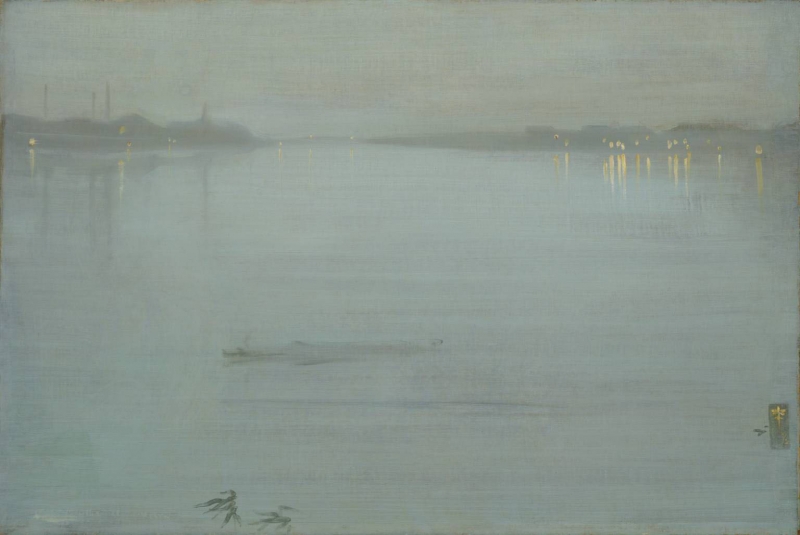Titles
Several possible titles have been suggested:
- Possibly 'Nocturne in blue and gold' (1875, Royal Pavilion Gallery, Brighton). 1
- Probably 'Nocturne in Blue and Silver' (1882, Grosvenor). 2
- 'Nocturne "in Blue & Silver" ' (1884, Whistler). 3
- '[Nocturne] Blue & Silver – Cremorne' (1886/1887, Whistler). 4
- 'Nocturne "Blue & Silver", Chelsea' (1892, Whistler). 5
- 'Nocturne. Blue and Silver – Cremorne Lights' (1892, Goupil). 6
- 'Symphony in blue & gold' (1892, J. C. Potter). 7
- Possibly 'Nocturne – Blue and Gold' (1898, Goupil). 8
- 'nocturne, "Glasgow Herald, Glasgow, 9 November 1893.", in blue and gold' (1893, Glasgow Herald). 9
- 'Nocturne in silver and gold' (1894, A. H. Studd). 10
- 'Nocturne en bleu et argent. Les lumières de Cremorne. (Nocturne in Blue and Silver. – Cremorne Lights)' (1905, Palais de l'Ecole des Beaux-Arts, Paris). 11
- 'Nocturne: Blue and Silver – Cremorne Lights' (1980, YMSM). 12
The painting may have been exhibited under various titles and is therefore difficult to identify with certainty in catalogues, and it is true the colours could be interpreted as grey or blue, or, more poetically, as silver or gold.
'Nocturne: Blue and Silver – Cremorne Lights' is the preferred title.
Description
A river scene in horizontal format, looking across and up a broad river, with factories and chimneys on the river bank at upper left, on a grey evening with lights reflecting from buildings on the right. A few leaves are just visible at lower left. Above them there is a faint suggestion of a small lighter, barge, or driftwood, on the water.
Site
It shows the river Thames, either from Whistler's house in Lindsey Row or perhaps from Battersea Bridge, with the Battersea factories on the left and the pleasure gardens at Cremorne, Chelsea, at upper right.
Although this view may have been painted from Whistler's house in Lindsey Row, it could have been based on drawings such as r.: Sketch of Battersea Reach for a Nocturne; v.: Illegible (skyline?) [M.0474]. Whistler drew and painted this view so often that he could have drawn it from memory, and such sketches probably formed the basis for some Nocturnes of the Battersea shore.
Comments
Andrew Wilton comments:
'It was noticed … that the series of night or twilight scenes on the Thames that Whistler painted in the early 1870s were a continuation of the thought behind the "Six Projects" of the years immediately preceding. The point is underlined by the fact that there are traces of a figure subject akin to those of the "Six Projects" beneath the paint of this Nocturne, a change of purpose that embodied for the authors of the 1994 catalogue "the transition from the decorative figure subjects of the 1870s to the Nocturnes and portraits which dominated the 1870s". As with Watts … the continuity between figure subjects and landscapes is real and significant ... Whereas Watts tended to incorporate literal or implied symbolic content in both his allegories and his landscapes, Whistler was content in both his arrangements of figures and his river views simply to suggest states of mind by means of subtly deployed colour harmonies and restrained compositional devices.
The composition of this Nocturne is a development out of the Nocturne in Blue and Silver 13 of the previous year: although rather wider in format, its layout is almost identical, with empty foreground and high horizon; yet its scale is much more expansive and its colour register higher, more luminous. The sluggish, sleeping river enclosed by the great capital city has given way to a silvery highway, seen from Battersea Bridge, leading to an enchanted fairground, the Cremorne pleasure gardens just beyond Chelsea: the opposition of man and nature seems here to be reconciled in a dreamlike idyll.' 14
Notes:
1: Second Annual Exhibition of Modern Pictures in Oil and Water Colour, Royal Pavilion Gallery, Brighton, 1875 (cat. no. 98), but see Nocturne: Blue and Silver - Battersea Reach [YMSM 119], Nocturne in Blue and Gold [YMSM 141].
2: VI Summer Exhibition, Grosvenor Gallery, London, 1882 (cat. no. 2).
3: Whistler to C. W. Deschamps, [11 January 1884], GUW #07909.
4: List, [1886/1887], formerly dated [4/11 January 1892], GUW #06795.
5: Whistler to D. C. Thomson, [4 January 1892], GUW #08214.
6: Nocturnes, Marines & Chevalet Pieces, Goupil Gallery, London, 1892 (cat. no. 34).
7: J. C. Potter to Whistler, 1 May 1892, GUW #05008.
8: A Collection of Selected Works by Painters of the English, French & Dutch Schools, Goupil Gallery, London, 1898 (cat. no. 25), but see Nocturne: Blue and Gold - Southampton Water [YMSM 117].
9: 'Literature', Glasgow Herald, Glasgow, 9 November 1893.
10: Studd to Whistler, 27 January 1894, GUW #05610.
11: Œuvres de James McNeill Whistler, Palais de l'Ecole des Beaux-Arts, Paris, 1905 (cat. no. 69).
12: YMSM 1980 [more] (cat. no 115).
13: Nocturne: Blue and Silver - Chelsea [YMSM 103], 1871, Tate Britain.
14: Wilton, Andrew, Robert Upstone, et al., The Age of Rossetti, Burne-Jones & Watts: Symbolism in Britain 1860-1910, Tate Gallery, London 1997 (cat. no. 80).
Last updated: 22nd November 2020 by Margaret







